Archive for ‘Work From Home’ Category
Paper Doll Wraps Up, Declutters, and Updates 2020
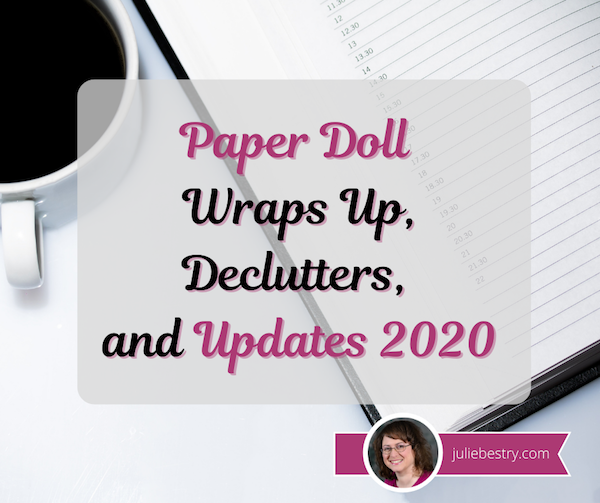
It’s been quite the year. “Unprecedented,” you might say. (Or, better yet, let’s not say. How about we purge that word from our vocabulary?) Before we turn the calendar page to 2021, there are a few additions and updates for the posts you read (or might have missed) over the past year.
PANDEMIC PRODUCTIVITY
The Now Normal: When the New Normal Changes Quickly
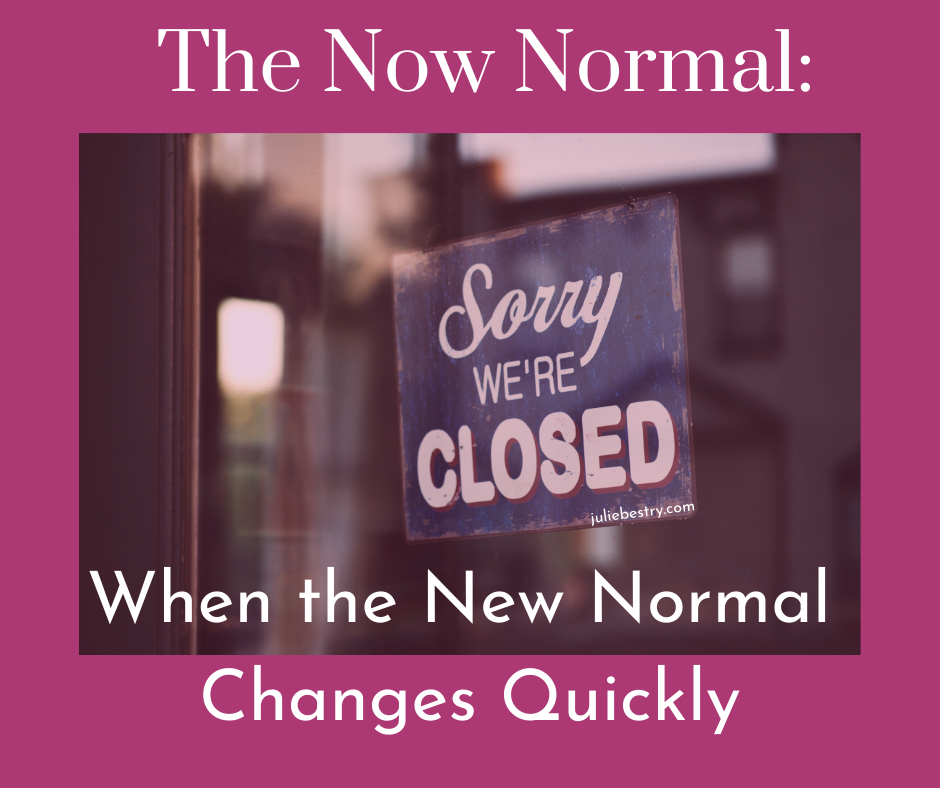
Back in March, none of us knew what the next nine months would bring. I’d acknowledged the difficulty of being at home, whether that meant working from home, home-schooling, or dealing with family and their foibles 24/7, and noted that at least, to some extent, we’d get used to it, or at least we’d have to get used to the “Now Normal” of things constantly changing and us not getting used to things. Little did we know how long (how very, very long) we’d be getting used to things constantly changing. I gave you all permission (as much as anyone needs permission from random internet bloggers) to be OK with not being OK.
Now, on the cusp of 2021, there’s light (in the form of a vaccine) at the end of this tunnel. But I suspect things will never go back to exactly where they were. Remote work had already been increasing (by 173% between 2005 and 2018); 2020 gave companies the impetus to make this a more permanent option. Companies that had believed workers could never be as productive when working remotely found that the opposite was true. According to research collated by Apollo Technical:
- Performance can improve up to 13% when working remotely (in a quieter, more convenient workspaces)
- Remote work yielded greater worker satisfaction
- Remote workers spend 15% less time avoiding work tasks
- Anecdotally, once supervisors trust the work-from-home approach and stop micromanaging, productivity increases.
This doesn’t mean we can extrapolate only good things to come out of more people working from home. Even once children and life partners are no longer in the home/work space, the distractions of household tasks (especially for women) will likely adversely impact productivity, and research indicates that productivity may take a hit due to prolonged lack of social interaction (especially for extroverts, like moi).
Some workplaces will stay 100% remote; others will return to traditional venues; and I suspect many employees will demand greater flexibility, and companies will want to consider the reduced overhead associated with smaller (or no) dedicated offices. The only thing we know for sure is that things will continue to change, and we’ll have to be nimble, accepting that the sand will keep shifting under our feet. As L.P. Hartley once wrote, “The past is a foreign country; they do things differently there.”
The only thing we know for sure is that things will continue to change...As L.P. Hartley wrote, 'The past is a foreign country; they do things differently there.' Click To TweetPaper Doll’s Ultimate Guide to Organizing a Virtual Field Trip
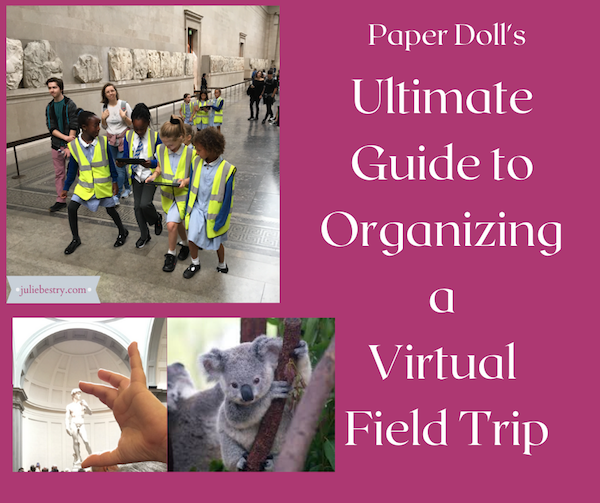
This post proved to be one of the most popular during the early pandemic. Organizing our days to include breaks, including virtual day trips to escape monotony, became a necessity this year, and rarely a week went by when a reader did not email or tweet or post to tell me about other cool virtual field trips.
Friend of the blog Janet Barclay knows that Paper Doll is a consummate Jane Austen fan, and forwarded Celebrate Jane Austen’s Birthday With a 360-Degree, Interactive Tour of Her House, and from there it was a quick hop, skip, and virtual jump to the Emma Thompson-narrated Twelve Days of Christmas special. There are also paid live virtual tours of Jane Austen’s House from Home, trails, and exhibitions. (Two live tours in January each go for £5, or about $6.78).
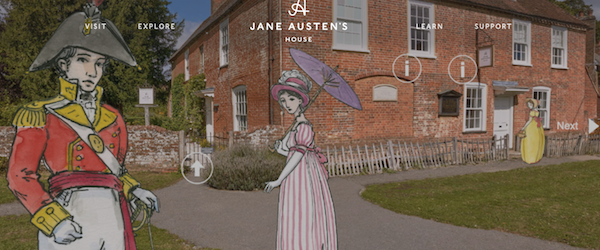
Discovery Education has developed a variety of live and on-demand, family-friendly interactive field trips. Each is free and includes a companion guide with hands-on learning activities! Take your kids to “visit” the Johnson Space Museum in Houston, see the cars of the future, hobnob with polar bears in the Tundra, and so much more. Whether you need a virtual field trip to break up winter vacation, quell home-schooling doldrums, or reverse just too little play time, Discover Education is a delightful addition to the options in my post.
Perhaps you binged too much of The Crown and need a reality check? Take a virtual tour of Buckingham Palace. Prefer a different venue? How about the Taj Mahal, the White House, or the Vatican?
Virtual Museums started an interactive map of the world’s museums available to virtual visitors. (Create an account to track and rate your visits.) From the Canadian Museum of Human Rights to South Korea’s National Museum of Modern and Contemporary Art to the mysterious fossils of the Graz Natural History Museum in Austria, new field trips for grownups are appearing all the time.
And if you need the the kind of field trip that takes you away from the hubbub, Escapista may be to your liking. Escapista has developed a manifesto to explain its approach to selecting opportunities for immersive meditative experiences, from pausing by a snowy river to Norway’s “Slow TV” experience of ten hours on a train. (Click the speaker icon to turn on the audio.)
Be sure to organize time in your life to relax and to learn for fun.
Does Anybody Really Know What Time It Is? 5 Strategies to Cope With Pandemic Time Dilation

There’s an irony of mentioning time dilation between two long weekends marked by Christmas and the new year. I’ve lost count of how many people have told me they checked for the mail on Friday or took the trash to the curb on the wrong day.
In the original post, I explained why our body clocks became so borked during our quarantine and recommended five strategies, with LOTS of tactical suggestions, for keeping everyone from becoming unstuck in time:
- Put structure in your life.
- Enhance novelty.
- Create vivid sensory clues for the passing of time!
- Get what you know you need! (Daylight, sleep, exercise, and for those of you who’ve had the same pair of sweats in rotation since St. Patrick’s Day, get dressed!)
- Take a technology break.
As a professional organizer and productivity coach, my job is to help people get more out of their time. But efficiency isn’t everything. In a year like we’ve had, and going forward, some daydreaming and navel-gazing preserves sanity. If you find yourself losing track of time too often, add in a bit of structure to your day and use technology to get a quick “beep-boop.” But do give yourself permission to enjoy the one small benefit of this year, living by your natural body clock.
Organize Your Health: Parental Wisdom, Innovation, and the New Time Timer® Wash

Don’t touch your face. Wear a mask. Wash your hands. It’s good advice, so listen to your mom. Listen to mine.
READING RENEWAL
12 Ways to Organize Your Life to Read More — Part 1 (When, Where, What, With Whom)

I’m not the only embracing tips for reading more. Oprah, the ultimate book club leader, may have ended her print magazine, but the December issue offered up 20 Simple Ways to Read More and Enjoy More Books in 2021. (Personally, though, I preferred my take on developing a reading nook. What do you think, readers?)
12 Ways to Organize Your Life to Read More — Part 2 (Reading Lists, Challenges & Ice Cream Samples)

Want to read more in 2021? You’ve got a bounty of options for finding recommended reading lists. One of my favorites is the NPR Book Concierge. (Find annual suggestions going back to 2013.)
If, instead of looking for a specific title, you want to find a 2021 reading challenge that, well, challenges you, opportunities abound, including:
The Uncorked Librarian (Most intriguing suggestion: read a book set on a train.)
Modern Mrs. Darcy (This year, it’s not just reading prompts, but an entire interactive kit for creating your personalized reading life!)
GirlXOXO Master List of Reading Challenges (While I’ll skip the challenge to read mysteries with cats as main characters, there are certainly lists galore for every taste!)
Meanwhile, who would be up for a Paper Doll reading challenge to embrace books on organizing and productivity?
How To Make Your Reading Time More Productive With Book Summaries
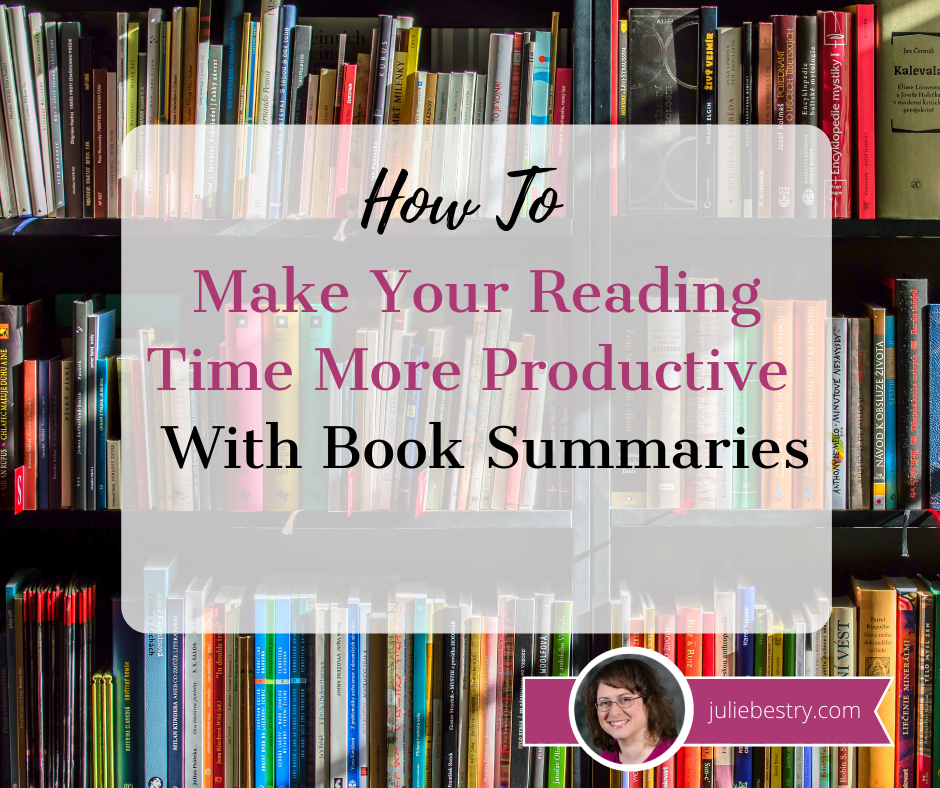
My coverage of book summaries focused on non-fiction. Unless you’re in 11th grade English class (sorry, kids), you probably don’t want summaries of novels. However, you can get ice cream tastes of fiction, to see if you like an author’s style.
- Most people are familiar with Amazon’s “Look Inside” feature, which allows you to click a link above the book cover and read a handful of pages. But did you know that many Kindle books have “Send a free sample” link so you can preview chapters? Check in the browser version, not the app, below the “purchase with one click” section and above the “add to list” button.
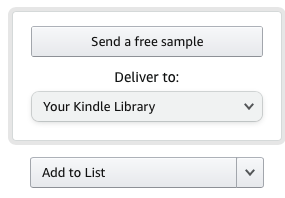
- You can also get a free audio sample. Check for a link under the book cover.

- Literary Hub has daily offerings of novel excerpts. Click on the book cover you want to try, and the resulting page provides short author bio and a selection from the novel. Titles range from new releases, like Mrs. Murakami’s Garden, to reprints of classics, like Betty Smith’s Tomorrow Will Be Better. (Literary Hub also has short stories excerpted from short story collections.)
PAPERWORK DECLUTTERED
Organize for an Accident: Don’t Crash Your Car Insurance Paperwork

In April and May, due to much of the country quarantining and people driving far fewer miles, many insurance companies offered 15%-25% premium rebates to customers.
While rebates largely disappeared by June, that doesn’t mean you should be paying full price if you’re still staying close to home. For example, if your workplace has decided to go “permanently remote,” and you no longer have a commute, it’s worth contacting your insurance agent about potentially lowing your premiums now that you are regularly driving less each week. One option insurance companies are exploring is vehicle telematics, little “black boxes” that keep track of your speed, mileage, and precision at accelerating and decelerating, and report back to the insurance company. Safer drivers get better rates.
Similarly, if your college-age student is not currently on campus and is attending school remotely (from your home), that means your car is in the driveway most of the time, not states or time zones away. Review your situation with your agent for the greatest number of discounts.
Paper Doll On Narwhals, Fake News, and How To Get A REAL ID

Everything in the post is still accurate except for the enforcement deadline. Due to COVID, the federal government delayed enforcing REAL ID by one year, to October 1, 2021. Remember, as of next October, if you don’t have Real ID-compliant identfication, you won’t be able to board a domestic flight or enter federal courthouses or restricted federal facilities, like military bases, nuclear power plants, or the White House.
Paper Doll Says The Tax Man Cometh: Organize Your Tax Forms

The forms are the same, but a few the rules have changed. Kiplinger’s Magazine covers a few dozen of the Tax Changes and Key Amounts for the 2020 Tax Year.
ORGANIZING ADVICE, PLAIN AND SIMPLE
The Truth About Celebrity Organizers, Magic Wands, and the Reality of Professional Organizing

As you head into 2021 armed with resolutions to get more organized, please review my counsel in this post. I stand by my word that there are no magic wands!
And in a future post, I’ll have more to say about advice from celebrity organizers with regard to organizing by color. Here’s a preview:

(Readers, if you like curry in your pumpkin pie, feel free to tell Jacki directly!)
Organize Away Frustration: Practice The Only Good Kind of “Intolerance”

This is the perfect week for you to take note of whatever frustrated you during the holiday season: a light system with too many broken bulbs, an artificial tree that has seen better days, a sense of obligation to send holiday cards to people who haven’t so much as liked one of your Facebook posts in a decade. Stop tolerating what doesn’t work for you, and if you don’t know the solution, seek help to find one.
Paper Doll Peeks Behind the Curtain with Superstar Coach, Author & Speaker Leslie Josel
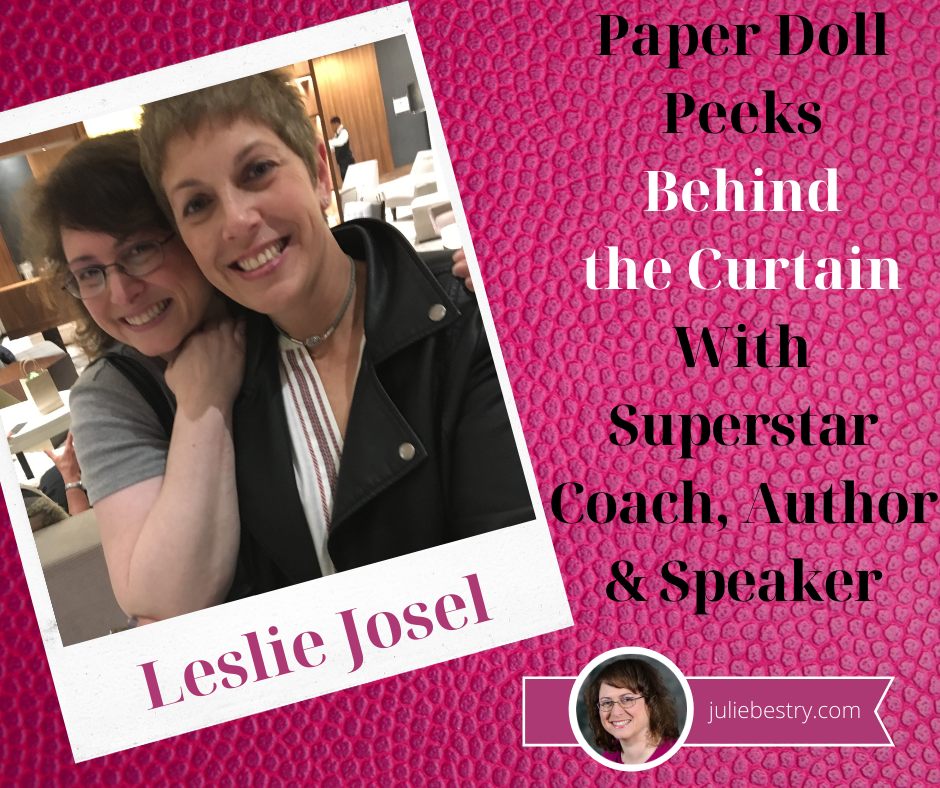
Our talk about 1980s sweaters may have been dated, but discussion of student procrastination is not. This fall was the first semester that was 100% in COVID times; even stellar students struggled, and “taking an incomplete” has become a common refrain. If you have (or are) a student, Leslie’s How To Do It Now, Because It’s Not Going Away should be on your bookshelf.
Organizing in Retrospect: A Confessional Look Back at 2020
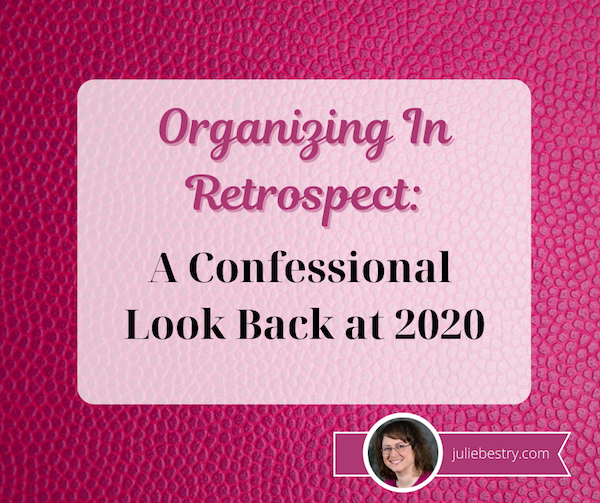
Writing this post, I realized I accomplished more than I realized. (Which would have been easy; when people asked what I’d been doing this year, I was often at a loss for words. “Missing my mom, my friends, and my travel plans, eating too much cheese, and craving Chinese food” seemed like an ineffective response.
This quiet lull before the new year is the perfect time to pull out your calendar and scan your To Do lists. Take notice of your achievements; in a year like this, it’s easy to forget small (and even not-so-small) victories. Ask your friends and loved ones to report back on the successes they recall from your year. Tally them up. Whether you use this in your next performance evaluation at work or just to buck up your self-esteem, remember that surviving this year intact is an accomplishment!
CLUTTER-FREE HOLIDAY GIFTS
In a Downton Abbey-themed post a few years ago, I told you about Give Back Box, a program whereby you could gather up the items your new holiday presents made redundant and easily ship them off to charity. This year, especially, when a touch-free donation option is especially useful, I encourage you to explore Give Back Box.
Clutter-Free Holiday Gifts for the Weird Year of 2020 (Part 1): New Twists on Old Favorites

For those of you looking for gifts of cooking classes, two highly praised options came in after deadline: King Arthur Baking‘s impressive calendar of interactive, online cooking and baking classes, and Milk Street‘s live-streamed and recorded, self-paced virtual classes. (If you give a cooking class gift to someone with whom you live, you get to eat the homework!)
Clutter-Free Holiday Gifts for the Weird Year of 2020 (Part 2): Giving Well, Giving Back

In addition to tangible gifts that give back to others, I wrote about charitable giving in your recipient’s name. Due to COVID, new tax laws let most taxpayers deduct cash donations of up to $300 made by December 31, 2020 when filing taxes in 2021 – even if you don’t itemize. (Note, this is a “per return” deduction, meaning married couples get the same $300 deduction as singletons. Consult your tax advisor.)
Clutter-Free Holiday Gifts for the Weird Year of 2020 (Part 3): Organizing Yourself & Others

Finally, I hope one of the gifts you give yourself is the time and opportunity to keep reading organizing and productivity advice here at Paper Doll.
Thank you, my dear readers, and have a happy, healthy 2021!
Does Anybody Really Know What Time It Is? 5 Strategies to Cope With Pandemic Time Dilation

Does anybody really know what time it is? (I don’t)
Does anybody really care? (care about time)
If so I can’t imagine why (no, no)
Chicago, Chicago Transit Authority, 1969
©Warner Chappell Music, Inc, Spirit Music Group
This is not a post about time management.
In full disclosure, I started writing this post in February for Time Management Month. Paper Doll strongly believes that we cannot manage time; we can only manage ourselves. But we do need to better understand time, to have a sense of how it passes. And for most of us nowadays, it’s passing…well…weirdly.
We don’t know what time it is. We don’t know what day it is.
I don’t know who needs to hear this, but today is Friday.
— Laura Marie (@lmegordon) March 21, 2020
Just asked my husband what day it is. He’s Googling it. I’ll get back to you all with the results.
— Elizabeth Hackett (@LizHackett) April 8, 2020
Alexa is getting tired of me asking what day it is.
— Rodney Lacroix (@RodLacroix) April 17, 2020
In case you were worried that it was just you, even the news media has been talking about it.
Once we settled into sheltering-in-place, many of us, especially those working from home, found it speeding by as we added work-from-home tasks, family tasks, and self-education tasks. We sought anything we could to stop April from feeling like the sluggish month of March. And what does May hold?
Why We’re Losing Track of Time
It’s not that strange that we’ve lost our sense of time. Think about the week between Christmas and New Year’s, where every day feels vaguely like Sunday. We’re not working, or if we are, there’s a strange hum of quietude. Is Grey’s Anatomy on tonight? Is it Trash Day?
Vacation days are like this, too. For the first day or so, we’re on “real” time, not only hyper-aware of what day it is, but when it’s 10:30a, even if we’re on a beach or in a museum, our internal clocks tell us that our colleagues are stepping away to the break room or the coffee truck. Vacationing parents may be dressing for a late romantic dinner out but be subtly aware that normally, they’d be corralling the tiny humans for bath-time.
But by a few days into the vacation? All of that gets swept away. When I went to Italy in 2018, I realized that by the time we left Rome, it was no longer Friday, but merely “Day 7.” My real life was a hazy memory.
We’ve Lost Our Sense of Routine.
There are no daily markers. We’re not going to work on weekdays or having our Monday stand-up meetings. We’re not attending religious services on weekends, and we’re not driving our kids to piano lessons on Wednesday or soccer practice on Thursdays. We’re not going to yoga. We’re not going anywhere!
We are used to marking time by space – weekdays mean work or school; weekends mean stores or attending religious services or restaurants with friends. Now, our dining rooms are schoolrooms; our kitchens are offices. Our living rooms become gyms. We’re in the same few rooms doing everything. Our surroundings aren’t changing even when our activities do, so even if we’re substituting virtual activities for the “real” ones, everything has an otherworldly, dreamy quality.
Further, we’re not doing any of the little things that mark the time advancing in smaller increments (minutes, hours) toward the bigger events. If we’re not getting up to go to work or school in the morning, there’s no reason not to read until the wee hours. If the kids aren’t going to school, there’s no rush to finish dinner and clean up the kitchen we can pack their lunches for the next day.
There’s a sameness to our days. There’s no ebb and flow to our hours. We’re moving through molasses and then we’re our own time-lapse videos.
We’re Busy, But We’re Not Being Satisfied
As a professional organizer, I split my time between working in clients’ homes and offices, usually in four-hour blocks, helping them achieve their organizing and productivity goals, and working in my office on the administrivia of small business: researching and writing blogs, providing organizing advice to media outlets (speaking of which, check out page 58 of the May 2020 issue of Real Simple), talking to prospective clients, marketing, bookkeeping, and so on.
Although some clients are opting to avail themselves of my services virtually, my workdays are now spent primarily in the 8-foot square box of my office. I’ve done enough webinars and classes, including Yale’s The Science of Well-Being, that I’m probably only a few webinars away from getting a pandemic diploma. I’m busy, but I don’t feel productive.
If you’re doing the work-from-home thing, you still have emails and phone calls and Zoom meetings to replace your “real” life, but deadlines are more amorphous. You may be actually getting more work done because you’re not getting distracted by Katie’s birthday cake in the break room or back-to-back meetings or getting cornered by Doug, who wants to talk about the cute thing his cat did.
But even if you’re busier (heck, even if you’re more productive), nothing has the same sense of immediacy, and sometimes that means we lose that sense of satisfaction what we’d otherwise get from having made it through Hump Day or having finally reached the weekend.
When There’s No Difference Between Tuesday and Saturday, Why Do Anything Now?
The Dowager Countess of Grantham has a point. What is a weekend anymore?
Why scramble to finish a project by Thursday afternoon if nobody will see it until Friday morning? Or Monday? Or May 73rd? Why focus your time and energy to complete your work by 5 o’clock if there’s nothing to separate from 2 o’clock in the afternoon from 9 o’clock at night?
Why? You know the answer…from the before-times. You know that it takes until about Martin Luther King, Jr. Day to feel like you’re back in the rhythm after a winter holiday break. Most of us have been sheltering-in-place six or more weeks. We need to have an accurate sense of time to be productive (whatever that means to you) both now, and later, when life returns to normalcy. We need to keep ourselves and our kids from becoming temporally feral, wildly eating and sleeping (or not sleeping), starting projects without finishing them, and generally feeling unmoored.
Allostatic Load and Lack of Novelty, or What the Heck Happened to Our Brains?
Our brains are getting mushy. In ‘Allostatic Load’ Is the Psychological Reason for Our Pandemic Brain Fog, the research indicates that our body’s physiological reactions to emotional stress can be powerful. Even though we’re sitting around not doing much of anything, our stress hormones are building up, exhausting our bodies. But we need physical energy to do mental labor, which (in addition to the emotional stress we’re already carrying) means that our brains are slowing down while we shelter-in-place.
Additionally, our brains are hungry for novelty. Every day looks and feels very much like every other, so when we’re not seeing new people, visiting new locations, or engaging in novel activities, our brains go on autopilot. We stop noticing details, so we stop making new or vivid memories, so everything blends together. Tuesday is Saturday is Everyday.
Our Body Clocks Are Borked
This isn’t all just psychological. There are physical reasons why we’re not sensing the passage of time the way we ought.
- We’re not sleeping normally. The weirdness of our schedules makes it tempting to stay up reading, or binge-watching, or gaming, and also makes it more acceptable to sleep later, getting us out of our normal habits. When we’re not going to bed or getting up at our normal times, it messes up our circadian rhythms and it distorts how short or long (or interminably long) any given day feels. If you sleep until lunchtime, it feels like it got dark awfully early. If stress-monsters woke you at 5 a.m., then by mid-afternoon, it feels like bedtime should be approaching. And because sheltering-in-place while we’re not getting a lot of new stimuli coincides with anxiety, we’re having weird dreams.
- We’re not sleeping, period. It would be weird to not be anxious right now. We’re worried about our health, and the health of our loved ones. We’re worried about our personal finances—Will unemployment benefits will ever kick in? Or if we’re still working, will our companies survive with everyone intact? — and the global economy. (Whatever you do, don’t check your 401k or IRA statements!)
- We’re not eating normally. OK, some of you are cooking Alison Roman recipes and making sourdough, and still setting the table, but most of us are grazing and not eating normal foods (or amounts) at what could only charitably be called “mealtimes.”
- We’re not getting fresh air. One of my colleagues lives in New York City and hasn’t been out of her apartment – not her building, but her actual apartment – in more than 45 days. She has no balcony, no roof access, and she’s avoiding her beloved, coughing doorman. Those of us with porches or backyards may be getting out more, but the weather around the country has been unpredictable. There were snowstorms in April. We’ve had tornados in Tennessee. And there’s pollen. So Much Pollen!
- We’re not getting sunlight. If we’re not getting outside, unless we have skylights or floor-to-ceiling windows, we’re just not getting a lot of the goodness provided by that big, yellow ball in the sky that helps us regulate our circadian rhythms and our moods.
- We’re overexposed to blue light. We’re Zooming and WebExing, in front of our computers all day without the break-room parties and water cooler convos that get us away from our screens. We’re texting with friends and reading Coronavirus news, binge-watching Amazon Prime and Netflix and Hulu. And some of you are gaming or playing Animal Crossing. All that blue light is wreaking havoc on our circadian rhythms, along with all the other things it’s doing to our eyes, or mental health, and our hormones.
5 Tips to Reconnect to Time
1) Put structure in your life.
Create the kinds of daily rituals that you wouldn’t bother with if this were a staycation. Have mealtimes at set hours. Living like we did before, where lunch came at 12:30 p.m. and dinner at 7 p.m. makes it less likely that we will graze our way to the Pandemic 15, but it will also put some definition in each day.
Develop buffer habits. If you can safely go for a walk before dinner, knowing you’ll do that between work and cooking gives you a “commute” of sorts. Listen to the podcast you’d normally dial up, or get back in the habit of calling your mom “on the way home” from work.
Time block to create boundaries in your day. I know I said this wasn’t a time management post, but time-blocking is a key strategy from the world of productivity. Block off specific times in your schedule for overarching categories: passive work projects, creative/active work projects, self-care, self-education, entertainment. A place for everything – in a schedule where everything has a place.
Even if your life doesn’t have any natural boundaries, you can create them to work as transition periods. Have one or two things on your schedule every day where you are honoring obligations to others so that you’ll wind up one task so you can show up for the next. Meet a colleague for a Zoom lunch. Hold an accountability call with a friend to help you both manage to shower and dress well before the day is half over!
Consider creating daily time blocks in which you work on a particular project most weekdays:
- 45 minutes of housework (laundry, cleaning, organizing, etc.) early in the day for a sense of accomplishment
- an hour and a half of working on your taxes (because the delayed due date of July 15th will be here faster than we expect)
- two hours of researching blog posts or sourcing graphics or planning meals
- a one-hour block, daily, of calling or video-chatting with someone
Micro-block your time with the Pomodoro Technique to conquer your tasks list. In case you’re not familiar with the Pomodoro Technique, it’s a time management system designed to battle procrastination and increase productivity. The very basic concepts? Identify what you want to work on, set aside 25 minutes to do so, and then do it – and that time in inviolable. If you let yourself get interrupted, you have to start over. Every 25 minutes, you get a five-minute break. Lather, rinse, repeat.
We’ve talked about doing pomodoros on the blog before, but for a more robust look at this incredibly effective method, my colleague Stacey Harmon has created a How to Focus in Uncertain Times Using the Pomodoro Technique® training, which she has made available at no charge.
Theme your days. Handle financial tasks on Monday Mondays. Solve problems on Weirdness Wednesday. It doesn’t just have to be activities. Celebrate Taco Tuesdays and have a meal you’re looking forward to eating…and even making.
2) Enhance novelty.
Go through your address book, your contact list, and our LinkedIn contacts. When you’re bored, or weary, instead of texting your BFF or your mother, with whom you’ve already spoken 43 gazillion times, pick two new people to contact each day.
Touch base with a professional contact and you never know what brainstorms may occur. Chat with an old friend just to find out what’s happening. Novelty can make each day more vivid and distinct from the day before.
Use different spaces. Do you have a guest room you hardly ever use for anything except piling up things that don’t have a home? Consider pushing the bed to the side to create floor space and do your workout routine there.
Is the idea of a guest room laughable?
ah yes the hotel-like guest room with a sea view that we definitely all have pic.twitter.com/8teYONwJuj
— Current Affairs (@curaffairs) April 27, 2020
Search your home for an underused space, maybe with the help of a tiny human. (They have a natural gift for such treasure hunts). As a toddler, I used to like to sit on the small steps from the kitchen down to our side to wait for my sister to return from school. In my current home, I’ve found that sitting and reading at the landing at the top of my stairs gives me good light and a feeling that my reading nook is a special place. Find a new space for an old task. Play cards in the laundry room. Picnic in the backyard.
3) Create vivid sensory clues for the passing of time!
The timer on my Fitbit buzzes at fifty minutes past the hour, reminding me to take 250 steps. Use that as your cue not only to walk, but to take your eyes off the screen. Fitbit’s reminder to move is built into the app, and most fitness trackers have a similar function. You can also try a movement reminder app like StandUp! to prompt you to take a break at a predictable time.
Whether you are bored or absorbed in an activity, a vibrating reminder that another hour has passed can help you acclimate. Similarly, you can set chimes or alerts on your phone to play hourly at 17 minutes past the hour, or set auditory alarms for every three hours, to remind you to take meal and longer activity breaks.
Go Analog. Digital clocks don’t give you the same sense of the passage of time as old-school watches and clocks. Start by looking to see which of your digital clocks you can change to an analog appearance. Android phones allow you to change your lock screen from digital to analog easily. On the iPhone, the clock app icon is a working analog clock, but the lock screen stays digital. There are apps like FaceClock Analogue to give you a working clock, but they can’t be added to the lock screen.
If you have a digital screen (like the kind for a rear-facing camera), your car will also probably let you change from a digital to analog clock.
Put a clock in places where you tend to lose track of time. Do you dawdle in the shower or while putting on makeup? Attach a small waterproof clock to your bathroom mirror with a suction cup to keep tabs on how long you’ve been debating cutting your own bangs. (Don’t do it. Just. Don’t.)

Embrace Time Timer – One of the favorite time management tools of professional organizers is Time Timer. I’ve written about many updates to Time Timer over the years, but the key thing to know is that the sweep of red helps your brain recognize time as it passes.
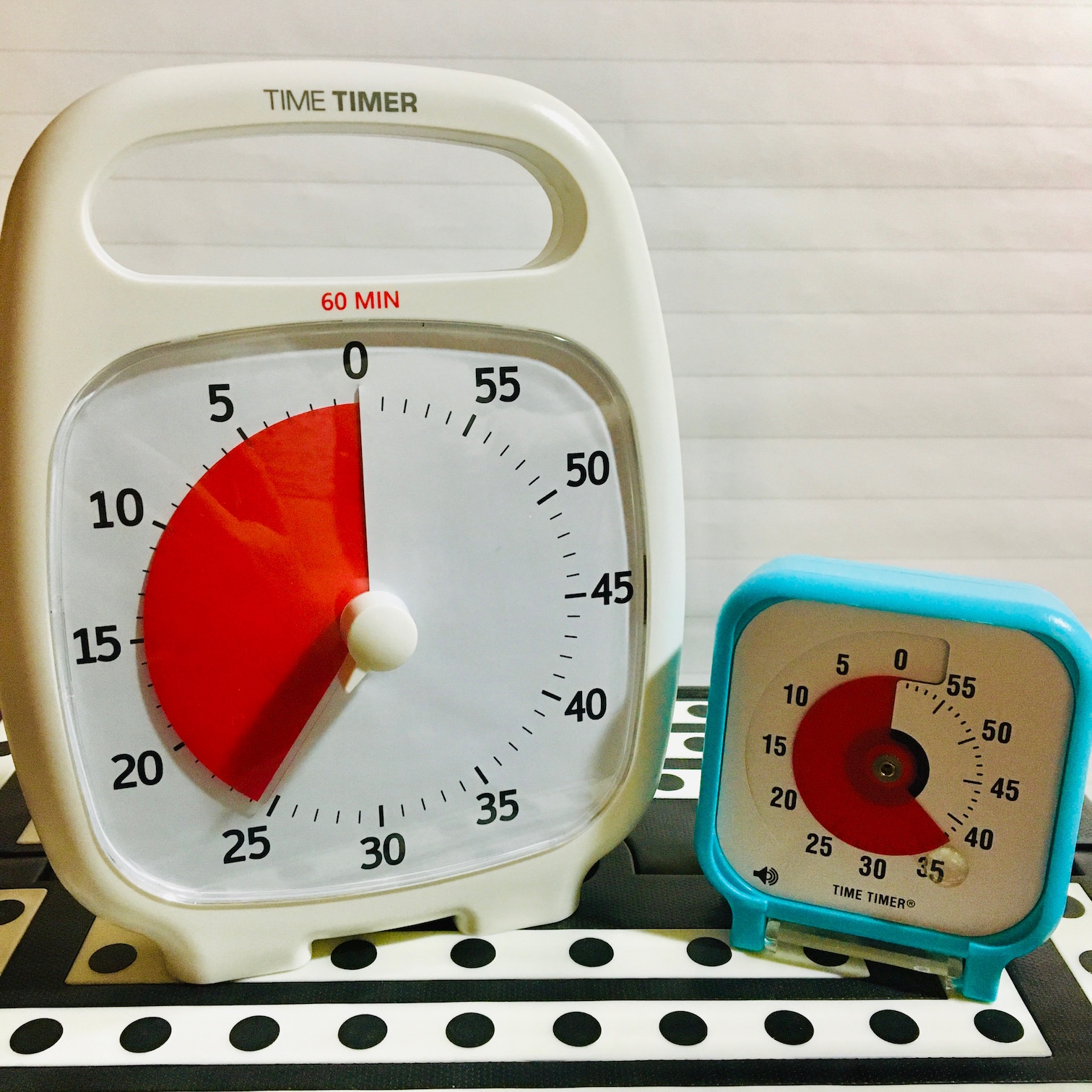
Please note, per Heather Rogers, the Co-President of Time Timer, “Until this crisis is over, the Time Timer apps for iOS and Android (available on the App Store and Google Play) will be free for everyone to help create some comforting structure wherever you are.
Also, all products at timetimer.com are 20% off with code HOME2020 and all US shipping is free while schools are closed.”
Of course, if analog isn’t retro enough for you, you could always take the sands-through-the-hourglass route.
Like sands through the hourglass, so are the days of our lives. Click To TweetYou won’t know what time it is, but if you take a few breaks to watch the time pass through a beautiful hourglass, you (and your kids) will have a stronger sense of how long five minutes or five hours really lasts.

4) Get what you know you need! The first month or six weeks of sheltering-in-place, we could be excused from letting everything devolve into an extended summer vacation, but now it’s time to get serious.
Get daylight. If you can get out and walk in nature (or your neighborhood) without encountering another unmasked human being within six feet, go for it. If you’re using the Pomodoro Technique, use your five-minute breaks to go outside. Jump rope or play hopscotch in the driveway. Run around the backyard. Dance to Lizzo on your balcony.
Get sleep. Close friends know that it’s ironic for me to give this advice, as sleep and I have a bitter and lifelong enmity. But the internet is chockfull of advice for getting enough sleep, even (and especially) if pandemic anxiety is keeping you awake.
Get exercise. Jumping to conclusions and stress-pacing aren’t enough. There are literally hundreds, perhaps thousands, of online workout options, from free to OMG-I-Can’t-Believe-I’m-Paying-Peleton. The standard go-to these days is Yoga With Adriene, but there are dozens of free live-streaming exercise classes (as well as recorded videos) to help you keep in shape. Or just run around with your kids or your dog.
Get dressed. Seriously. I know the jammies are comfy, but even having day-PJs and night-PJs isn’t enough. You don’t have to put on shoes, but if you shower, groom yourself, and actually put on underwear and real clothes each morning and change for bed each night, your sense of time will improve.
5) Take a Technology Break – There are all sorts of ways to get some social distance from your devices.
Give yourself a tech timeout every time you realize you’ve lost an hour to social media or cable news. (That’s where the fitness tracker reminders come in!) Leave the devices in a separate room during mealtimes. Talk to the people in lockdown with you, or if you’re alone (or just don’t like your peeps all that much after six weeks in the same house), read a book.
Put yourself and your family on a tech curfew. There’s nothing that happens after 8 p.m. (or 11 p.m., or whenever you’ve set the curfew) that you can’t catch up on the next morning. Give you eyes a break from the blue light.
Consider taking a Tech Shabbat. In 24/6: The Power of Unplugging One Day A Week, Tiffany Schlain makes an excellent case for the physical, mental, and social benefits of stepping away from the technology for a whole day.
Does anybody really know what time it is? Paper Doll really cares.
Paper Doll’s Ultimate Guide to Organizing a Virtual Field Trip
 Do you remember the field trips you went on as a kid? Even if the trip was headed somewhere you’d been before, or someplace that wasn’t that exciting, there was something compelling about having to turn in that golden ticket of a permission slip, having a shortened class schedule, getting on a bus, perhaps having to hold hands or hold onto a rope, and getting shushed by the teacher in a brand-new environment.
Do you remember the field trips you went on as a kid? Even if the trip was headed somewhere you’d been before, or someplace that wasn’t that exciting, there was something compelling about having to turn in that golden ticket of a permission slip, having a shortened class schedule, getting on a bus, perhaps having to hold hands or hold onto a rope, and getting shushed by the teacher in a brand-new environment.
Growing up in Buffalo, I visited Tifft Farm Nature Preserve and learned how maple syrup was tapped, how maple sugar candy was made, and never to drink a beverage if your field trip is anywhere with outhouses instead of bathrooms!
As a kindergartner, I visited the Mirrored Room at the Albright-Knox Art Gallery, and was transfixed by the mirrored walls, ceiling, and furniture, although the mirrored floor terrified me. Would I fall through into another world?
Throughout elementary school, I got to visit the planetarium built right into one of the district’s newest high schools (giving me an unrealistic expectation of high school fun). And on multiple visits to the Buffalo Museum of Science, I was shocked to come face-to-face with a wooly mammoth.
Yes, my sandwich was always soggy by lunchtime, and my feet were usually tired by the time the bus returned to school, but the whole experience gave kids a burst of energy during long stretches of weeks without holidays.
Couldn’t you use a field trip right about now?
Every day, another thousand blogs tell you how to effectively work from home, entertain and education your children, and be productive on a myriad list of home projects, all during the uncertainties of sheltering in place. And certainly, Paper Doll has thoughts on all of those things. But that’s not what today’s post is about. Because you need a break. (OK, I need a break. Even professional organizers lose their motivation in these wooly mammoth times.)
While you may not be able to take a drive downtown or hop on a subway, you can still ease your mind and stir your soul. You may not be able to pop out to the library, but you can borrow ebooks from your public library. You may not be able to attend a workshop, but there are TedTalks galore. But there’s nothing like the energy of going on a field trip…so off we go!
ORGANIZE FOR A VIRTUAL FIELD TRIP
It’s far too easy to click on some links, making your experiences every bit as quotidian as clicking over to Instagram or going down a rabbit hole of YouTube videos. To make your field trip a mental, emotional, and visceral experience that feels like an adventure, follow these steps.
1) Make a production out of it. Get dressed up. Go outside, walk around the driveway, and come back in with fresh eyes. If your kids don’t have a lot of experience with museums, you can talk about how (when we go on real field trips), we don’t run, how we talk in hushed tones, and how we don’t push people, but we will be rewarded with magical experiences in huge rooms and bright colors and cool sites.
No tiny humans? You and your partner could dress in your fanciest clothes (or, y’know, not the same sweats you’ve been wearing all week) and agree to make the trip as vivid and special as possible. No stopping to check Twitter, no doing laundry.
On your own? Make it less of a solo excursion by sharing the experience with friends. Post a photo collage of yourself, your lunch (of which, more later), and the home screen of your visit’s location. “I’m going to the Louvre today. Ask Me Anything!” Periodically, post something surprising that you’ve learned. Even if you’re alone, you don’t have to be lonely on your field trip.
Even if you're alone, you don't have to be lonely on your field trip. Click To TweetMake time for your trip. Don’t just sandwich a quick whirl through the web between working on your sourdough starter and bingeing the next episode of Kitten Prince. (OK, I know, but I’m not giving that show any more press!)
Build it into the homeschool day, or schedule it for after dinner on a work-from-home Zoom-filled workday. Experiences are far more memorable than tangible things, which is why they make better gifts than things that turn into clutter. Give yourself a gift of the field trip experience.
Pack a lunch. Remember the brown paper sack lunches for field trips? Paper Mommy was always a room mother, helping corral the kids, but she tucked a note and a little doodled self-portrait into my lunch, folded in with my napkin, nonetheless. Perhaps you could tuck a little quiz or puzzle into a bagged lunch for your kids (or partner, or housemate)?

Or do the museum café thing and try to make a fancy coffee. Break out some wine and quarantine cheese, and make a night of it. When I toured the UK last September, we had gorgeous weather in Scotland, Wales, and most of England, but our only full day in London was dark and rainy all morning, and plagued with kerfuffles. Once we got to the British Museum, we were feeling a bit overwhelmed; there was too much to see in the few hours we had, and we were damp and cranky. After an hour of trying to hit the guidebook highlights (including the actual Rosetta Stone!), we stopped at one of the pop-up cafés on an upper floor, and surrounded by art, had little cakes and beverages, which refreshed our bodies and gave us verve.
You’ve been locked in for perhaps a month. Take your verve where you can get it!
Do some research. Learn things before you set off for about what you’re about to see, and wrap up with investigating more about what you’ve just experienced. If you were in school, your teacher would prepare a unit in art or Social Studies (do they still call it that?) or science so you’d know a bit before the big day.
Heading to a National Park, if only in your mind? Find out how Teddy Roosevelt helped to create the National Parks System, or sign your tiny human up to be a Junior Ranger. Going to a Van Gogh exhibit? Watch the (whole) Doctor Who episode, Vincent and the Doctor. (Grab tissues.)
Ask some questions and share your thoughts. What did you like best? What surprised you?
When I was small, Paper Mommy taught me a game where we looked at each painting in which a person or animal appeared, and we narrated what they were thinking or feeling. In general, we were snarky, but I’ve now played this game in every museum or art gallery I’ve ever visited, from Chattanooga to Chicago, from Cannes to London to Florence, making up a cinematic backstory for every “character” or scene played out in grand paintings and sculptures.

(What do you think he’s thinking?)
Visiting sea or land creatures on your virtual visit? Talk to your kids about what you learn, and ask them to compare or contrast aspects of how the animals care for their young or live with their families to the way humans do it. With a fellow grownup? Discuss aspects of animal life you wish more humans embraced. Or, y’know, talk to one another in faux animal voices. You do you, boo!
Thinking and wondering, rather than just looking, makes your field trip (and the things you saw on it) much more vivid.
Make a plan for a real field trip in the future. Quarantine will end. Someday, we will be traveling again, visiting again, vacationing again. Use what you learn on your field trips to make some proactive, mindful plans to help you hold on to your vision of the future.
Visit the gift shop. No field trip is complete without looking through the tchotchkes being sold. Some places, like the MOMA, have gift shops that rival Amazon for the amazing things you can acquire. But by visiting virtually, there’s no pressure to quickly decide between making a purchase or missing out. (And most museum shops, like the Musée Dorsay store, has temporarily suspended shipping orders, anyway.) Bookmark the product page, and you can always return to buy 24/7 if there’s something that captivates you days or weeks after your field trip.
The rest of this post is designed to give you a whole host of thrilling options for your field trips, but please feel welcome to share your own favorites in the comments. Where have you visited? Where will you go?
EXPERIENCE THE WORLD’S NATURAL BEAUTY
One of the most exciting ways to travel while sheltering in place is via one one particular new exhibit and interactive documentary from the increasingly cool Google Arts & Culture project. It was launched this spring to celebrate the Centennial of the National Parks Service. (Thanks, Teddy!)
These are no mere coffee table book photos. You can take 360° tours of U.S. National Parks. You probably know a little (or a lot) about the big ones, like the Grand Canyon (yes, even if all you remember is what you saw that Brady Bunch episode!) or Yosemite.
But this exhibit concentrates on the parks you might know less about, like Alaska’s Kenai Fjords, New Mexico’s Carlsbad Caverns, Florida’s Dry Tortugas (which sounds like a food truck menu item), Utah’s Bryce Canyon, and Hawaii’s volcanoes.
Of course, once you start searching for virtual field trip options in the world of nature, the opportunities seem boundless. Consider the Nature Conservancy of Oklahoma‘s OK360° guided tours and hikes.
Wish you could commune with nature? Take a virtual dive with the National Marine Sanctuaries and visit some watery depths from American Samoa to the Florida Keys to the Olympic Coast. Virtual dives let you see an underwater habitat (and even some sunken treasures) using only your computer, phone, or virtual reality headset.
Be cure to check out nature-oriented livestreams, too, like:
The Cincinnati Zoo and Botanical Garden, where you can visit with Fiona, the baby hippopotamus.
The Georgia Aquarium’s African Penguin webcam; you can also visit the tuxedoed birds’ neighbors via the beluga whale, alligator crossing, and piranha webcams!
The world-famous San Diego Zoo’s webcams — apes, baboons, burrowing owls, condors, elephants, pandas, polar bears, tigers, butterflies…take your pick, but right now, I’m sticking with their koala cam!
The New England Aquarium’s virtual visits follows along as the penguins are fed or the giant ocean tank is cleaned, and there’s a YouTube playlist of all of the NEAQ’s virtual visits.
Canada’s Farm Food 360° offers eleven virtual tours, from dairy cow and egg farms, to sheep and pig farms, to grain farms and feed mills. Sometimes, nature isn’t just there to be seen, but to help sustain us as well.
And if the natural world of days gone by is more your field trip style, take a jaunt through the online exhibits of the Smithsonian’s National Museum of Natural History. Perhaps you’ll feel less like a dusty fossil after a panoramic view of some old bones (and butterflies, and gems, and ancient history).
TAKE A VISIT TO THE ART MUSEUM
Not really an outdoorsy person or an animal lover? (Paper Doll feels your pain.) You can focus your mind with art!
Start with Google Arts and Culture’s Uffizzi Galleries, where you get the Google “street view” of Florence, Italy’s most famous art gallery. (I visited the Uffizzi in 2018; it’s breathtaking, in terms of both the art and the views of the city through upper floor windows, but I’m sure this virtual visit is less exhausting.)
Not all tours need to be 360° visits. Sometimes, you want to see things up-close and personal. Paris Musées, a group of 14 Paris museums, including Maison de Balzac, Petit Palais, and Maison de Victor Hugo, have made high-resolution digital copies of 100,000 artworks freely available to the public on their collections website. Look at everything (making a daily lunchtime field trip) or stare at one work, transfixed, like Cameron at the Chicago Art Museum in Ferris Bueller’s Day Off. (While you’re at it, read what filmmaker John Hughes had to say about those scenes!)
Weren’t we talking about Van Gogh a little while ago? Amsterdam’s Van Gogh Museum, which houses the largest collection of the tortured Post-Impressist master, has put nearly one thousand of his paintings and drawings online and developed a Van Gogh At Home teaching program to help parents share art with their children.
So even if you feel like you haven’t been out of your house in 132 years, you can snuggle under a blanket and view Van Gogh’s 1888 The Bedroom from the comfort of your own room.

Other amazing options for an art-related field trip:
The Solomon R. Guggenheim Museum in New York, NY.
The Art Institute of Chicago in Chicago, Illinois.
The National Gallery of Art in Washington, DC. (One current virtual tour is Degas at the Opéra! Also check out Google Arts and Culture’s panoramic tour of the NGA.)
The Smithsonian’s National Portrait Gallery in Washington, DC. (In addition to the Google Arts and Culture tour, the NPS has designed a “Visit at Home” program.)
Always wanted to visit the Louvre? Open Culture has gathered three high-definition videos from Wanderlust Travel Videos so you can see Mona Lisa‘s smile, but also many lesser-known works.
Musée Dorsay in Paris, France.
Tate Modern in London, England – From the Bath of Psyche to 500 Years of British Art, you’ll have your pick of views.
The British Museum in London, England is huge and glorious. And exhausting. But they’ve developed 11 tips for exploring from home and you won’t have to jockey for a view of Rosetta Stone.
Is this feeling too highbrow for you? What about a Google street view of 12 Banksy murals?
Maybe you don’t even want to take a field trip to see the art, per se, but you just want to see art about the art? The Metropolitan Museum of Art in New York City has developed a map of the museum for the whole family. (Scroll down, then read the article at Atlas Obscura.)
Don’t feel like even thinking about where to click? Just want the experience to wash over you? How about this 5-hour, one-take journey through St. Petersburg, Russia’s Hermitage Museum. 45 galleries, 588 masterpieces. Sure, it’s basically an ad for Apple’s iPhone 11, but it’s worth the price of admission (which, of course, is free).
And if you don’t know where you’d like to take a field trip to see art, try the Art Camera. Pick just one piece of art (Manet’s The Conservatory? Frieda Kahlo’s Self-Portrait With Monkey? Rembrandt’s The Night Watch?) and get up-close and personal with just one painting, learning every brush stroke.
GET SOME PERSPECTIVE FROM YOUR COUCH
It’s easier for art museums to put their collections online. History museums and interactive exhibits are a little more complex. However, whatever fascinates you in this world likely has a museum. Try firing up your search engine and typing in the subject, the word museum, and “at home” or “virtual” to see what comes up.
The Smithsonian’s National Museum of African American History and Culture has video resource guide for exploring their archives available from home. This might be the perfect time to participate in the Community Curation Project, sort your photos, and find your family’s history in American history.
The Smithsonian’s National Museum of American History has over 100 online exhibits. They aren’t all ready-for-Prime-Time, but if history is your jam, field trips to the past will keep you busy for so long, you’ll forget that you’re sheltering in place while you’re traveling in time.
The National Women’s History Museum has a wide variety of exciting online exhibits on topics as wide-ranging as the women of NASA to women in Congress, from women who campaigned for suffrage and civil rights to women who waged World War II.
Things will get better, so consider signing for memberships with your local cultural venues. Time Travelers is a reciprocal membership network for historical museums and societies throughout the United States. Members of historical institutions can receive exclusive benefits and privileges at museums and historical sites nationwide, including free or reduced admission, gift shop discounts, free parking, and much more. Your local museums, zoos, and other venues likely offer similar reciprocal opportunities.
GRAB SOME LITERATURE WITH YOUR LATTE
Perhaps a poetry reading is more your style? Patrick Stewart has been reading Shakespearean sonnets, most in numerical order, each day. (He declared that #5 was “too hard.”) Here’s just one.
Sonnet 3#ASonnetADay pic.twitter.com/hI4GzH49P8
— Patrick Stewart (@SirPatStew) March 24, 2020
EVERYONE IS BEAUTIFUL AT THE BALLET (AND THE OPERA, TOO)
You already know about music streaming services like Spotify and Amazon Music, but what about visiting the opera or taking in some classical music?
The Metropolitan Opera is offering nightly streams of operas, as well as free streaming events for students.
London’s Royal Opera House has a massive YouTube playlist of the Royal Opera and the Royal Ballet. The sidebar includes affiliated groups, like the Welsh National Opera and the Scottish Opera.
The Berlin Philharmonic is presenting livestreams, though I’ve yet to find a translation option for English. But music is supposed to be a universal language!
AND MORE
As a professional organizer, I eschew clutter. As a curious person who fancies herself a completist, I like to collect ALL of the options.
And if nothing I have suggested piques your interest, the MCN (formerly the Museum Computer Network) had a mind-boggling list of hundreds of virtual museum resources to serve your needs: museum portals, art and cultural museums, museums of history and natural science, online exhibits, e-learning opportunities, and digital archives. Suddenly, it almost seems like quarantine won’t last long enough.
I know you probably wish you were out and about, but until we are all traveling freely about the planet, unmasked, take some time to give yourself some daily or weekly delights. Have some great field trips. Just skip the ones that only have an outhouse.
11 Ways To Organize Your Focus With Ambient Noise
Are you a shush-er, or a shush-ee?
When you drive down the street, searching for a house number, do you turn your radio down? You’re probably a shush-er — you need quiet to focus.
When you sit down at your desk to work, create, or do homework, does silence make you jittery? You may be a shush-ee. You need sound to help you maintain your concentration.
THE MOST STRESS-ER-FUL TIME OF THE YEAR
College students are dealing with the end of the semester, writing papers and studying for exams. Worker bees have the usual deadlines, but with the added stress of end-of-year projects and quotas, as well as two major challenges to productivity and focus:
Time is at a premium. In addition to work, you’ve got holiday shopping, and travel, and school concerts and recitals, and a plethora of tasks crowding you out of your carefully crafted time management system. (OK, some of you are laughing at that last part.)
Distractions are high. Everyone’s playing holiday music. Kids (and grownups) are sugared-up and noisier than usual, the weather is unpredictable, forcing you to carve more time out of your work to leave early enough to get where you’re going, and there’s mounting pressure to finish things before the new year, as if there’s a moral failing in carrying projects over.
ADD SOUND TO DELETE FURY
Blast those distractions out of the water with big audio dynamite. (OK, not this Big Audio Dynamite.) Or, if not blast, lull you into the right cognitive mood for learning and/or creating.
According to Is Noise Always Bad?: Exploring the Effects of Ambient Noise on Creative Cognition, in the Journal of Consumer Research,
“A moderate level of noise enhances creativity compared to both low and high levels of noise. Moderate background noise induces distraction which encourages individuals to think at a higher, abstract level, and consequently exhibit higher creativity.”
Not all sound/noise is created equally, and it’s not all experienced in the same way by everyone. We can generally agree that we won’t be focusing if someone runs their fingernails on a … OK, I won’t say it. You know. But while one person might be able to do geometry homework to heavy metal, another might be easily distracted by the sound of a steady radiator hiss.
So what can you listen to if you want to maintain focus?
This isn’t a science blog, but it helps to know a bit about what colors of noise can do.
- White noise uses sound across all frequencies from high to low, with a “flat” spectrum. It’s considered helpful for deep focus on tasks such as studying, reading or writing.
- Pink noise combines both low and high frequency sounds, creating an effect akin to a waterfall or shower, creating a soothing, spa-like auditory environment. So, if you’re stressed and want to relax before giving a presentation, leading a meeting, or even coping with holiday carpool schedules, go pink.
- Brown noise sticks with the lower frequencies, creating a rumble-y, tumble-y, riding-on-a-train auditory sensation. While it’s said to be useful for aiding sleep, it also works well to mask external noises like when your co-worker snaps her gum or your ice maker clunks loudly.
HAVE A SHOWER AND SOME COFFEE
Do you get your best ideas in the shower? Showertime’s Virtual Shower can help you create that environment without drenching your computer.
It’s browser-based — just click on the link and pick the settings you prefer:
- How Long — Select options from 1 to 10 minutes.
- Size of Room — The volume and echo changes as you enlarge or reduce the size of your shower spa.
- Pressure — The intensity of pressure generally correlates with volume and robustness of the audio
- Radio — Pick from a handful of shower-themed musical choices (Splish, Splash, Singing in the Rain, Rubber Duckie, Raindrops (Keep Falling On My Head), or soft jazz).
- Water Temperature — Choosing Hot, Neutral or Cold lets you change the screen’s color scheme.
Click Start to get going. If you’re feeling a bit like Janet Leigh and think you hear a knife-wielding psycho (or just need to move on to another task), click Stop.
Virtual Shower is free.
Coffitivity appeals to our omnipresent coffeehouse culture. If you’re a Silent Sam or Sally, you may wonder how anyone could want to do work in a coffeehouse, let alone feel like they are while at home or the office. But Coffitivity’s take on that same Journal of Consumer Research study is:
“According to a peer-reviewed study out of the University of Chicago, “A moderate level of ambient noise is conducive to creative cognition.” In a nutshell, this means that being a tiny bit distracted helps you be more creative. This is why those AHA moments come when we’re brushing our teeth, taking a shower or mowing the lawn!”
When you go directly to the web site, the first thing you hear is the busy humming of a coffeehouse: people talking, the occasional click of a keyboard, cups and silverware clinking against tables. The Cafe Library includes different types of background sounds: Morning Murmur is a more gentle hum, while Lunchtime Lounge is a little more energetic, and University Undertones has more collegiate chatter. There’s a premium level subscription ranging from $3-9, which offers Paris Paradise, Brazil Bistro or Texas Teahouse, though the site says the premium level is currently unavailable.
Use Coffitivity in your browser or get the app for iOS or Android.
Cafe Restaurant from MyNoise.net, though less well-known, offers a similar, though more customizable, service. It’s available for the browser and in an iOS app. (An Android version is in the works.)
Use the sliders to adjust audio element styles that include the levels of Rumble, Restaurant, Chatter, two separate levels for Babble, Mess, Cafeteria, Cafe, Table and Kitchen.
MEDITATE AND FOCUS
Perhaps you’d like a less caffeinated approach?
Calm makes you feel like you’re meditating…while getting a massage…at a yoga retreat. It’s got a very Zen with a capital Zzzzzzzzz approach. The settings are not entirely intuitive, but you get to select from among a variety of background visuals: a summer field, rays of sun on the ocean, waves along the beach, flowing water. The musical selections appear to be pre-set and all by musician Kip Mazuy, though you can cycle through the nature audios (waves, flowing water, etc.) to choose your preferred sounds.
Select guided calm for 2, 5, 10, 15, or 20 minutes for a hypnotic guided meditation, or use the timer to listen to the environmental options.
For more features than are offered in the browser, the Calm app is free, with in-app upgrades, for iOS and Android.
Focus@Will describes itself as “a new neuroscience based web tool that uses specially sequenced instrumental music to increase your attention span up to 400% when working and studying. Our tool helps extend your productivity cycle and effortlessly zones out distraction.”
Music options include low-, medium- and high intensity choices, and a variety of music channels, including Classical, Focus Spa, Up Tempo, Alpha Chill, Acoustical, Cinematic, Ambient, Water, Baroque Piano, ADHD Type 1, and others.
Other features included a productivity tracker and the ability to set timed sessions to fit with your planned work schedule. For example, if you use the Pomodoro Technique and work in 25-minute increments, you can set the music to end when your alarm goes off.
Focus@Will offers a 30-day free trial with limited access to the proprietary music, after which subscriptions are $4.9/month or $44.99/year for full access to the music library. Use it in your browser or via the iOS and Android apps.
WHEN THE WEATHER OUTSIDE IS FRIGHTFUL…OR NOT
Noisli isn’t just a white noise generator; in fact, the quirky service isn’t just any one thing.
It can be used solely as an audio system. In this regard, you can click on any number and combination of the icons to select sound options: rain, thunderstorm, wind, forest (mainly birds), leaves (rustling in wind and rain), stream, seaside, water (as from a faucet), bonfire, summer night (crickets), coffeehouse, train, and fan shop. Use sliders to increase or decrease the intensity of each sound chosen.
Noisli is also a color generator. After you bring it up on the screen, options morph through different color palettes. In full disclosure, Noisli is my favorite of all of the options, not just for the sound alternatives, but because all of the colors are so comforting.
But here’s where it gets interesting. Noisli is also a distraction-free, markdown-based text editor. (Markdown is a simplified formatting language, a kind of text-to-HTML converter for people who don’t want to have to learn HTML.) The colors in the window continue to change, but otherwise, it’s just a big, blank screen. You type plain text (or with markdown syntax) and whatever you type will be saved locally, even if you close your browser (though there is a button to save and download whatever you write).
Noisli is free in your browser; the iOS app is $1.99.
A Soft Murmur has no text editor and the browser background (which may be waves or a very up-close-and-personal view of coffee) is static, but it’s stylistically similar to Noisli. Select from icons depicting rain, thunder, waves, wind, fire, birds, crickets, a coffee shop, a Tibetan singing bowl (uh…OK) and pure white noise.
The Meander function causes the volumes of any selected sounds to randomly increase or decrease. The timer allows you to set increments ranging from 1 to 999,999 minutes (whoa!) and to determine whether you want the audio to start and stop or fade in and out.
A Soft Murmur works in the browser; an Android app is free, with in-app upgrades of $1.49.
SLIGHTLY LESS STORMY WEATHER
Fire, wind, water, rain…and singing bowls? If you prefer fewer input options, there are a variety of services.
Rain, Rain, available as a free Android or iOS app, gives you lots of alternatives (rain, waves, fountains, blizzards, crackling fires), with even more choices if you choose to upgrade to a premium version. Adjust the audio, set the timer, and sit back.
One of the nicest features is that you can lock your device and Rain, Rain will continue to play. Pause, adjust the volume, or change the tracks from the lock screen.
Rainy Cafe offers a fairly minimalist browser interface. Turn the cafe sounds on or off. Turn the rain sounds on or off. Adjust the volume for either or both. That’s it. Easy choices for a rough day.
Rainy Mood is both more and less minimalistic than Rainy Cafe. On the browser, there’s nothing adjustable. Just listen to rain. (OK, and occasional thunder.)
If you get either the iOS app ($3.99) or the Android app ($2.99), you can adjust the volume of the rain and the thunder (including “100 unique thunderclaps”). You can also simultaneously play anything from the music library on your device or in your Spotify account.
Snowy Mood is a browser-only experience that appeals to my roots as a native of Buffalo. (Play on Chrome for the best performance.)
I focus best on long-term strategic thinking when taking walks. I sometimes miss the sounds of walking across the Cornell University campus during the quiet nights of Study Week. Snowy Mood provides exactly that experience. The audio soundtrack is simply the plodding of heavy boots crunching through thick snow, with an occasional howl of wind. It becomes almost hypnotic after a while. For those who need the extra inspiration, the screen shots cycle through a handful of unpeopled snowy scenes.
These options only skim the surface. Search your favorite app store or search engine for terms like “sound generator” and “white noise” to find hundreds of options for your preferred device and format. But if you’re playing the audio loudly and without headphones, don’t be surprised if someone shushes you.



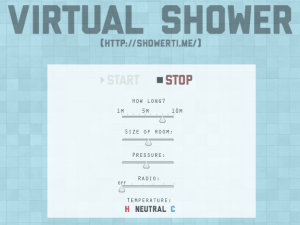



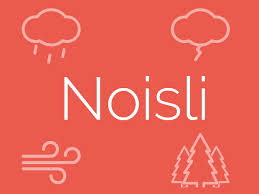
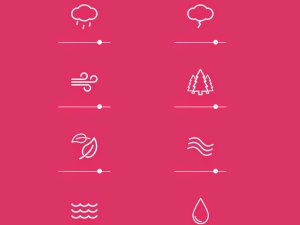

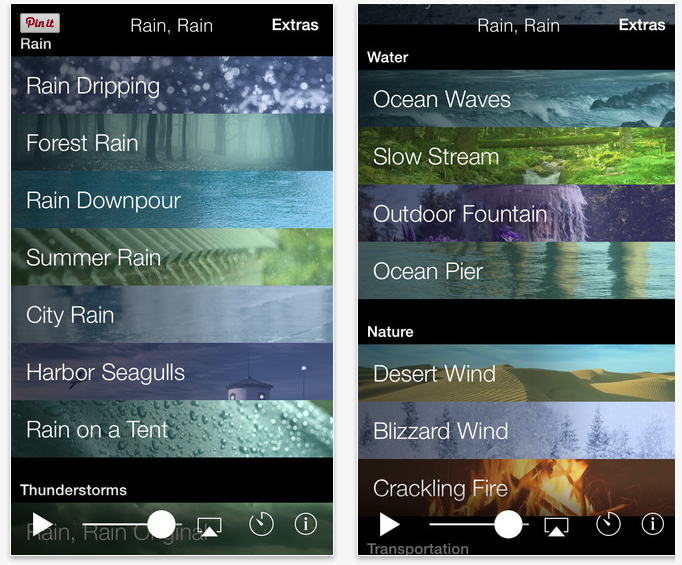




Follow Me